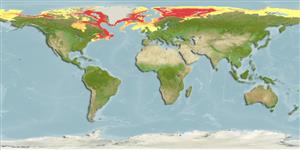Environment: milieu / climate zone / depth range / distribution range
Ekologi
laut dasar (demersal); kisaran kedalaman 6 - 1750 m (Ref. 117245). Polar; 83°N - 41°N, 180°W - 180°E
Circumarctic (Ref. 11954). Northeast Atlantic: northeast Greenland, Jan Mayen Island, northern coasts of Iceland, Faroes-Shetland slope, northern part of Barents Sea, White Sea and around Spitsbergen. Northwest Atlantic: Arctic Canada to Labrador and Gulf of St. Lawrence; possibly to Cape Cod in Massachusetts, USA (Ref. 7251). Arctic Ocean: Kara Sea, western part of Laptev Sea, Beaufort Sea and Arctic Canada. Subspecies(?) Lycodes pallidus marisalbi in White Sea only (Ref. 4695).
Size / Weight / umur
Maturity: Lm ? range ? - ? cm
Max length : 26.0 cm TL jantan/; (Ref. 4695); common length : 18.0 cm TL jantan/; (Ref. 4695)
deskripsi pendek
Kunci identifiaksi (pengenalan) | Morfologi | Morfometrik
vertebrata, bertulang belakang: 90 - 93. Pelvic fins small (Ref. 4695). Young with pale, yellowish-brown body, with 6-8 light and narrow cross bands which are more distinct on the dorsal fin; larger individuals lose the bands, becoming more or less uniformly colored (Ref. 4695).
Found on muddy bottoms (Ref. 4695). Benthic (Ref. 58426). Feeds mostly on endobenthic prey such as small bivalves, polychaetes and small crustaceans in addition to detritus. It seems to get the bulk of its food by burrowing in the sediment (Ref. 13532). Ripe females recorded in September in the Kara Sea (Ref. 4695). Minimum depth from Ref. 58018.
Life cycle and mating behavior
Maturities | Reproduksi, perkembang biakan | Spawnings | Egg(s) | Fecundities | Larva
Anderson, M.E., 1994. Systematics and osteology of the Zoarcidae (Teleostei: Perciformes). Ichthyol. Bull. J.L.B. Smith Inst. Ichthyol. 60:120 p. (Ref. 11954)
Status IUCN Red List (Ref. 130435)
ancaman kepada manusia
Harmless
penggunaan manusia
Alat, peralatan
laporan khas
muat turun XML
Sumber internet
Estimates based on models
Preferred temperature (Ref.
123201): -0.9 - 4.9, mean 0.8 °C (based on 2262 cells).
Phylogenetic diversity index (Ref.
82804): PD
50 = 0.5000 [Uniqueness, from 0.5 = low to 2.0 = high].
Bayesian length-weight: a=0.00263 (0.00137 - 0.00504), b=3.22 (3.06 - 3.38), in cm total length, based on LWR estimates for this Genus-body shape (Ref.
93245).
Trophic level (Ref.
69278): 3.1 ±0.36 se; based on food items.
Daya lenting (Ref.
120179): sedang, Waktu penggandaan populasi minimum 1.4 - 4.4 tahun (Preliminary K or Fecundity.).
Fishing Vulnerability (Ref.
59153): Low vulnerability (16 of 100).
